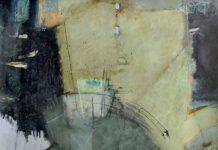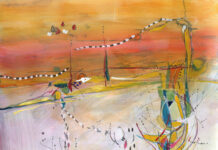
By Christopher B. Crosman
Timothy James Standring gets around. The small watercolors in The Loaded Brush — his show on view through late July at the gallery of the Maine Coastal Islands National Wildlife Refuge Visitor Center in Rockland, Maine — hail from the mountains and foothills of Colorado, Wyoming, Nova Scotia, and Maine, among other places. A seasoned museum professional and former curator at the Denver Art Museum, Standring is familiar with masterworks on paper, having organized shows featuring monotypes by Giovanni Benedetto Castiglione, pastels by Edgar Degas, and watercolors by both Jamie and Andrew Wyeth. Alongside his museum career, he has painted watercolors during frequent trips to the Netherlands, France, Spain, Switzerland, Italy, and other locales, often in conjunction with the major international exhibitions he has organized.
The charm of Standring’s watercolors lies in an unaffected, gently seductive focus on the momentary, seemingly casual pleasures of simply looking at nothing in particular. We become aware of place evoking memory, our own, perhaps, and certainly the artist’s. He surveys his locations — and they are his once paint touches paper — with an eye for the subtleties of shifting light. The individual paintings are different from each other but share qualities of quietude and closely observed details of ephemeral nature, especially as to liquidity, airiness, and immanence.
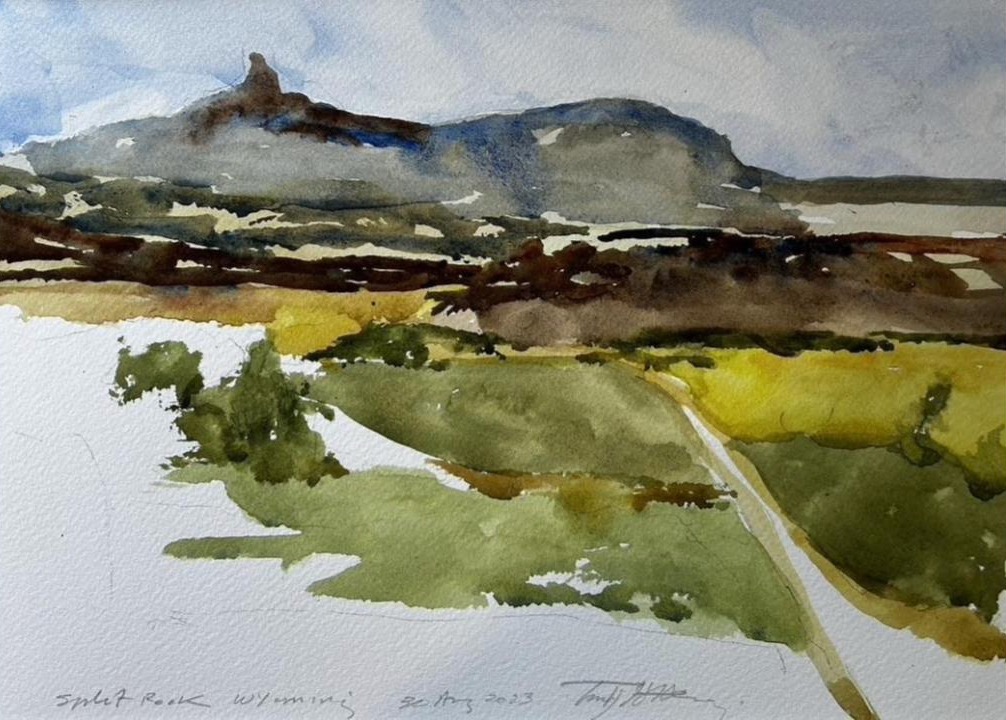
In part, because of its ease of transport — paper, paint, water allowing unfettered freedom to travel — watercolor became “the American medium.” Since the mid-19th century, artists like George Catlin, John James Audubon, John Singer Sargent, Winslow Homer, Rockwell Kent, and others packed up their sketch pads and paint boxes and traveled across the Americas and Europe, exploring new and old worlds of light and atmosphere.
Today, Standring’s watercolors come from a lifetime of looking at great works of art. He is deeply conversant with the history and techniques of his medium. Ingrained in his approach is a rare knowledge of the materials and craft necessary for intuition to happen — that “abstract flash,” as Andrew Wyeth called it, catching the eye and becoming available to the artist’s practiced eye. Artists who know and live with the old masters — as Standring has done for most of his long curatorial career — have an abiding, almost intercessionary, relationship with them. His pictures seem to say, “I do this in honor of and homage to great artists I love!” No apologies are needed for work that carries the weight and historical authority of earlier masters of the medium to the present day, when watercolor is having something of a moment in contemporary art.

Standring acknowledges the difficulty and immense history “this fickle medium presents.” Watercolor is unforgiving; depending on viscosity, watercolor goes where it wants, does what it wants. The illusion of control is simply that: an illusion. Skillful artists know this and use it. He observes: “I paint quietly. Often, I pencil in faint lines of a composition and then erase most of it. Next, I’ll cover the sky with a clear wash, and before it dries, lay in glazes of rose madder or lemon yellow along the horizon. I’ll then repeat the process by dropping in washes of aquamarine, tilting the paper to move the puddle in various directions. Conversely, I’ll sometimes use my brushes to mop up the color to give the illusion of billowing clouds, with passages of yellow ochre, Davies grey, or Payne’s grey to capture what I am experiencing.”
Capturing what he is experiencing, not replicating exactly what he sees is the intention. Even in those watercolors where the unpainted white paper frames the dissolving peripheries, Standring heighten a sense of surface and the ambiguous, fluid boundaries between illusion and reality. “As a rule,” he says, “I also prefer not to fill the entire sheet, but instead leave a lower-left or right-hand corner unpainted, which to my thinking reinforces the fact that the work is a painting rather than a reproduction.” If looking down on the Rocky Mountains or up at giant upthrust geological remnants — such as Standring’s Red Rocks — can ever be thought of in terms of immediacy and intimacy, it will come from an artist who knows such places with a lover’s familiarity and passion.
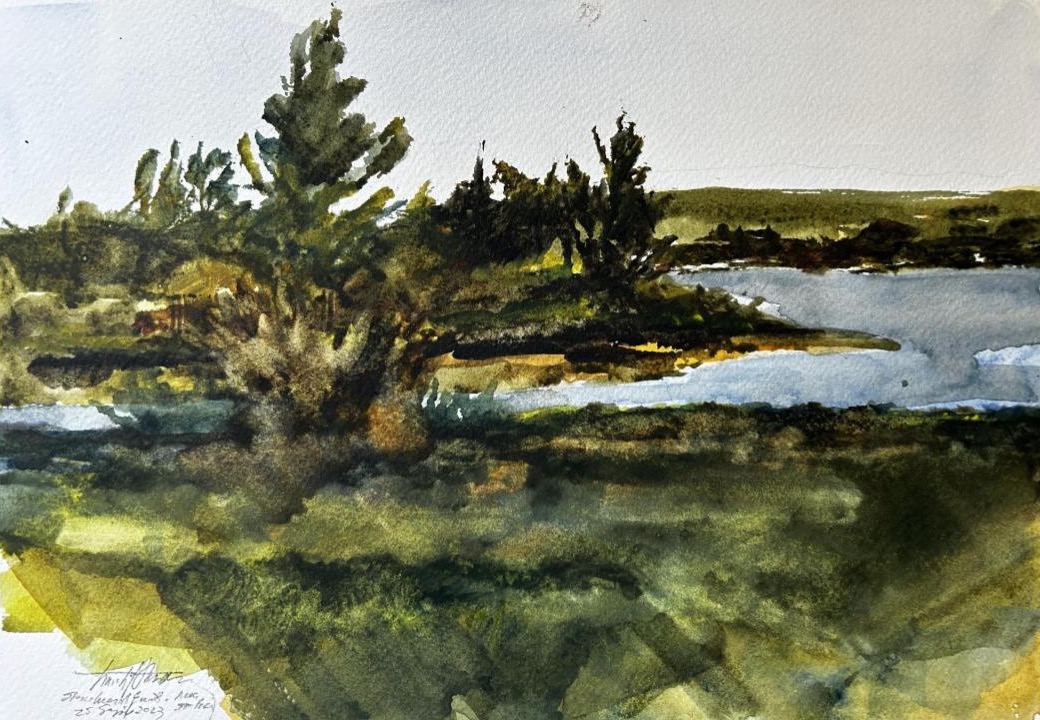
THE ARTIST’S PLEIN AIR PROCESS
As with most plein air artists, Standing finds the paper he uses nearly as important as the paint. He uses a paper aptly called “Stonehenge” — alluding, perhaps, to druidic mysteries and rites of passage. Or, the perfect paper to suggest the presence of leaning, monumental boulders in Colorado? Good watercolor paper allows colors to penetrate and be absorbed into the organic fibers of the paper itself. Its lightly mottled surface provides a soft “bite” and texture to shimmering, moisture-laden skies and water, as well as looser, drier, dustier climes in the West. And the way the artist gently articulates movement in skies and foliage is related to how he “tamps down the edges by gingerly grazing a sable brush against the paper at an angle.” Texture and color fuse with the grain and fiber of the paper, the singularity of paint bound with and of its supporting surface. The rocks are not on the paper, they are in it.
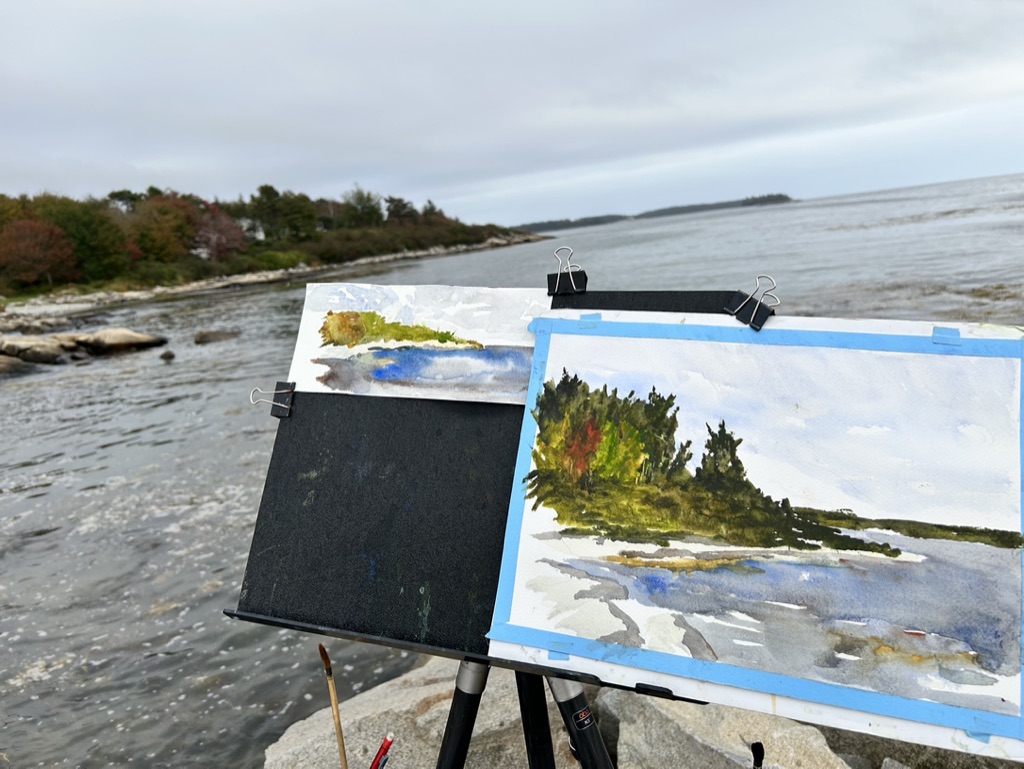
Standring was once asked whether his paintings were “fact or fiction.” He replied, “Neither. A mediation between the two.” And a meditative one for the viewer, as well, as we marvel at the caressing touch and quiet tonal shifts. The silence in these self-effacing works comes from a quality of modern American minimalism, absorbed, perhaps, through his other curatorial life and a 21st-century zeitgeist. Curators of Standring’s generation were taught to recede from view, disappear into the machinery of museum exhibitions, in order to shed light on the art and artists they wished others to note, celebrate, and understand. Now, he is one of them. He tells us, “I’m an art historian who loves to paint and wishes to be known as an artist.”
Tuning ambiguity, color, and movement to bell-like clarity and personally resonant meaning is really what both artists and curators strive for. Indeed, his lifelong aim to be “in the moment,” his effort “to capture what I am experiencing,” and to mediate between what an artist knows about a place and the poetry of the passing moment, is what these small watercolors do best.
Information: Maine Coastal Islands National Wildlife Refuge Visitor Center, 9 Water Street, Rockland, Maine 04841, www.mainecoastislands.org/events/. The Center is also presenting an exhibition of recent works by members of the Pastel Society of Maine. Timothy James Standring is represented by Gallery 1261 (Denver) and Claggett-Rey Gallery (Edwards, Colorado).
Christopher Crosman is the founding chief curator of the Crystal Bridges Museum of American Art in Bentonville, Arkansas. He also served as executive director of the Farnsworth Art Museum in Rockland, Maine. His career in art museums has included stints as director of the Heckscher Museum on Long Island and head of education at the Albright-Knox Art Gallery in Buffalo. He now works as a freelance curator, consultant, and writer focusing on art and artists, past and present, connecting Maine to a wider view of American art. He and Timothy James Standring serve on the Board of the Wyeth Foundation for American Art.

